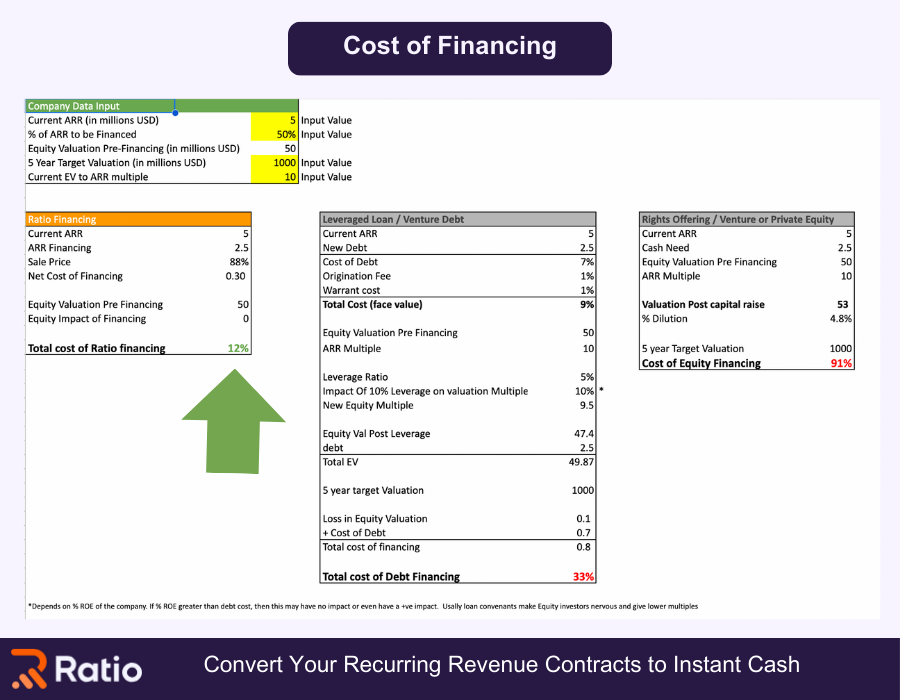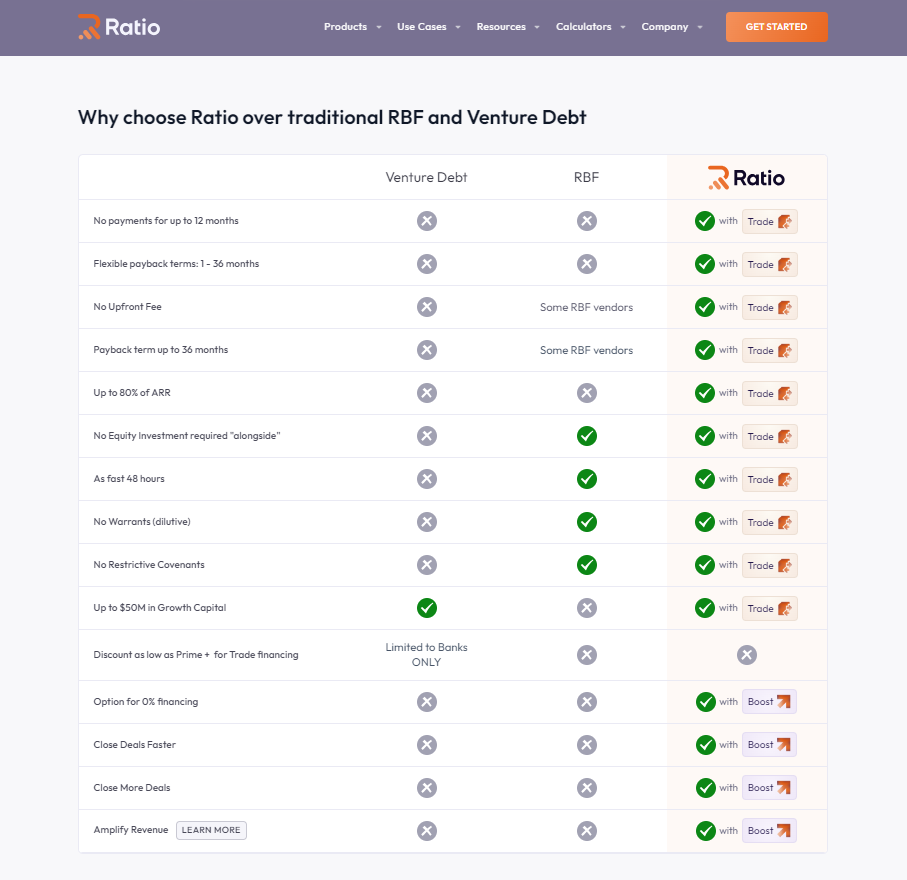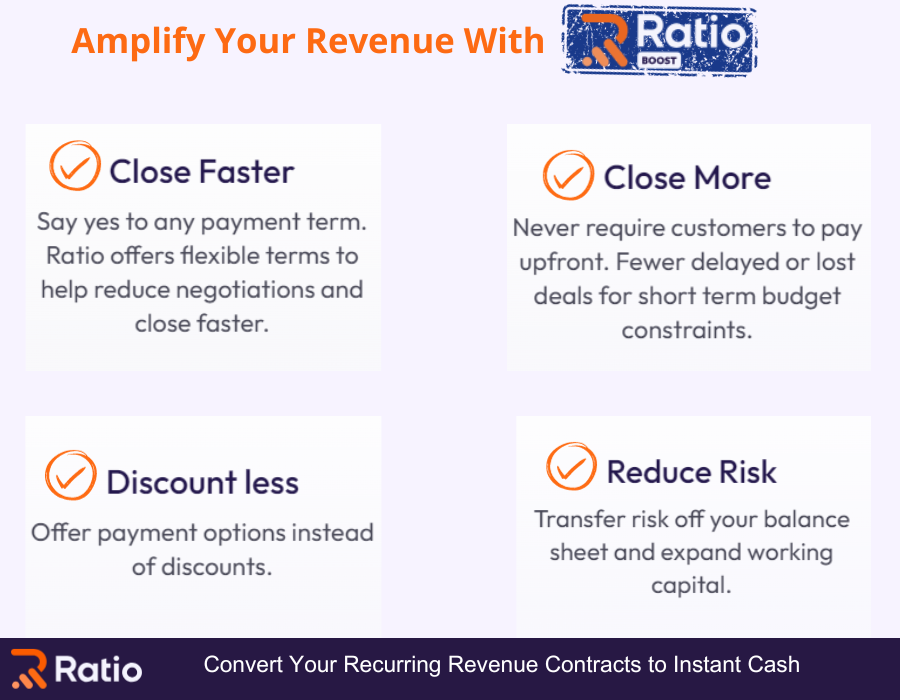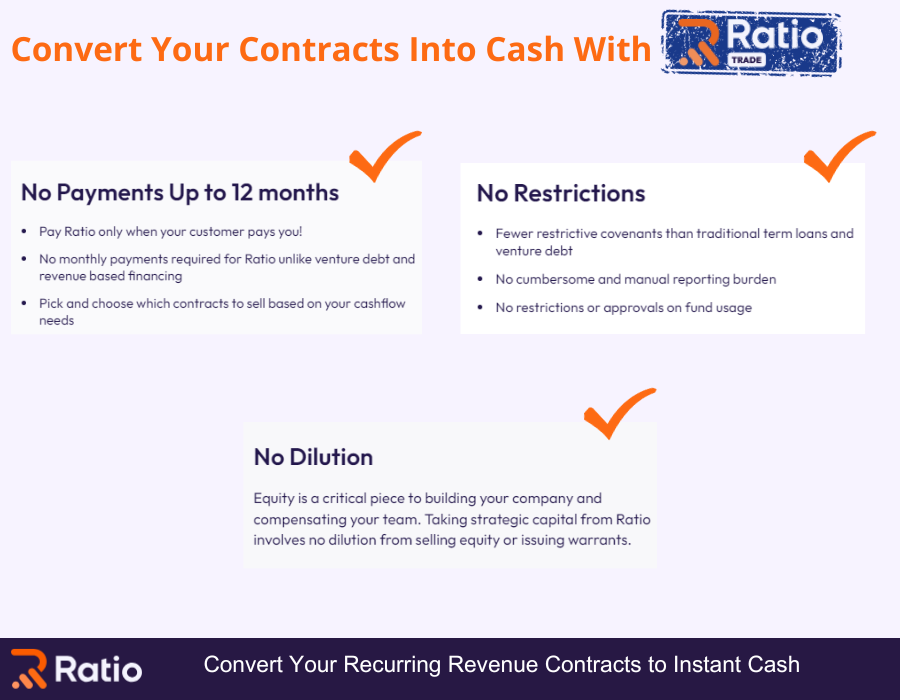Understanding Recurring Revenue Financing: A Comprehensive Guide for SaaS Businesses
SaaS businesses are booming, thanks to their flexible payment models that attract deals but result in smaller, steadier revenue streams. This often puts a strain on this industry as they wait for revenue to build up.
Recurring Revenue Financing (RRF) offers a pivotal solution in this scenario.
RRF allows businesses to tap into future subscription revenues now, ensuring a stable cash flow essential for operations and growth. As your customer base grows, RRF scales up, providing more capital and preventing financial hurdles from slowing your expansion.
For SaaS companies, RRF is the key to sustainable growth without losing ownership. It frees entrepreneurs from investor meetings and ownership dilution, letting them focus on growing their businesses.
The demand for subscription-based payments extends beyond SaaS to sectors like Robotics-as-a-Service. RRF's appeal is strong here, too, especially given the industry's capital-intensive nature and lengthy deal negotiations.
This guide dives deep into Recurring Revenue Financing. We'll explore how RRF can unlock capital for your company, supporting robust growth or stable operations in an unpredictable market.
Recurring Revenue Financing 101
Recurring Revenue Financing, as defined by The Legal500, is a financial tool tailored for businesses with consistent, contract-based customer payments.
It's especially beneficial for companies that have stable subscription incomes, offering upfront cash in return for a portion of future subscription earnings.

This non-dilutive option allows businesses to secure funding while retaining ownership.
Imagine you're running a SaaS business with $10k monthly in subscriptions; you're on track for $120k annually. However, if you are in immediate need of capital, RRF partners like Ratio can help. They might advance you $100k to $115k of your $120k contract value upfront, collecting payments as your customers pay you.
Moreover, it’s Ratio who would be bearing the underwriting risk for you. This immediate capital boosts the company's ability to drive business growth by expanding its team, enhancing marketing efforts, improving customer experience, or even developing new products.
It's a prime example of how businesses can leverage the stability of their Monthly Recurring Revenue (MRR) and Annual Recurring Revenue (ARR) to create a solid, predictable financial base.
The Mechanics of Recurring Revenue Financing
Industry experts predict that the market for recurring revenue loans will surge to an estimated $40B by 2026. This growth extends beyond the technology sector, with various companies leveraging steady income streams to embrace this innovative financial model.
Understanding the Process:
1. Assessment of Revenue Streams
Lenders start by evaluating the company's financial health, focusing on the predictability and stability of its recurring revenue streams. Most RRF partners do not request personal guarantees from entrepreneurs seeking capital.
The evaluation includes examining the company's customer churn rates, the lifetime value of a customer (LTV), and the growth trajectory of the revenue. The lender conducts a thorough review of the company's financials, business model, market, and customer base.
2. Agreement on Terms
Post-assessment, the company and lender agree on the amount of capital that can be borrowed, which is determined by the analysis of revenue streams.
The repayment plan is typically tied to a percentage of the company's Monthly Recurring Revenue (MRR), offering flexibility that aligns with the company's financial performance.
This adaptable repayment strategy ensures that payments are manageable and proportional to the company's current income.
3. Funding
Once terms are agreed upon, the company receives the capital, often much quicker than through traditional financing routes. The application is approved or declined within hours, and funds are typically disbursed within a few days or weeks.
This expediency is one of the many appeals of Recurring Revenue Financing, offering businesses rapid access to funds.
4. Repayment
Recurring revenue loans offer a flexible repayment plan where companies pay back borrowed capital plus fees through a fixed percentage of their monthly recurring revenue. This means payments fluctuate with income, decreasing during slower periods and increasing when earnings rise.
It's a cash-flow-friendly solution that adjusts to the business's financial performance, ensuring payments are manageable and aligned with current revenue.
5. Revenue Performance Monitoring
Revenue Performance Monitoring involves lenders regularly checking a company's revenue to possibly adjust repayment terms and ensure the company's growth is on track with its financing. This process helps maintain a healthy financial relationship and supports the business's upward trajectory.
6. End of Term
At the end of the term, once the set amount is fully repaid, the financial commitment concludes. However, depending on its needs and the initial terms, the company may opt to refinance or extend the agreement for continued financial support.
Highlighting Nextech3D.ai's Strategic Move
Nextech3D.ai, a prominent supplier of generative AI-powered 3D models to major e-commerce retailers like P&G and Amazon, secured $2 million from FinTech Ratio.
Achieving this without diluting any equity is a testament to the power of leveraging future invoices for immediate capital. The funds are designated for further advancement of their AI technology, showcasing the strategic advantages of Recurring Revenue Financing.
The story of Nextech3D.ai illustrates the significant benefits of this financing approach. It's not just about gaining immediate financial leverage but also about promoting strategic growth, flexibility, and the sustainable advancement of software companies.
RRF vs. Traditional Financing Models
While traditional financing is a common choice for small businesses, its strict criteria, lengthy approvals, and potential for increasing debt can be particularly challenging for SMEs, especially those that are young, not have enough financial history. This makes it a less-than-ideal option for companies that are new, innovative, and fast-growing, with a higher risk-return profile.
This is precisely where Recurring Revenue Financing (RRF) steps in as a viable alternative.
RRF aligns with your company's revenue model, offering a less frictional way to secure funding without even diluting any equity. It's suitable for companies with steady and growing revenue streams, changing the game by scaling access to capital as your business expands.
Here's how RRF differs and potentially benefits your business:
1. Basis of Lending
Recurring Revenue Financing
RRF is more suitable for businesses with predictable, regular income, particularly subscription-based models like SaaS companies. Lenders focus on the reliability and consistency of these revenues, viewing them as a reflection of a company's financial health and growth potential.
Traditional EBITDA-Based Financing
In traditional financing, lenders evaluate a company's EBITDA (Earnings Before Interest, Taxes, Depreciation, and Amortization), favoring businesses with significant assets and a history of profitability. It's a more established approach, with lenders scrutinizing past financial performance and asset valuations.
Typically, this type of loan requires borrowers to provide collateral and personal guarantees, ensuring lenders are protected.
2. Loan Structure
Recurring Revenue Financing
RRF typically offers more adaptable repayment terms that are linked with revenue, sometimes incorporating an equity component, like a warrant.
Traditional EBITDA-Based Financing
Conversely, traditional loans often come with a set payback period. You usually make regular payments, covering both interest and principal, until the loan's fully paid off.
3. Application and Approval Process
Recurring Revenue Financing
The process for RRF is often expedited, focusing primarily on revenue data rather than extensive financial history.
Companies like Ratio can offer rapid 48-hour approvals and quick capital transfers.
Traditional EBITDA-Based Financing
Traditional methods require a more meticulous, time-consuming due diligence process, demanding comprehensive financial statements and a thorough historical record.
4. Cost of Capital
Recurring Revenue Financing
- Potentially Lower Cost: Suitable for high-growth companies with stable, predictable revenue streams, leading to a lower risk and potentially lower cost of capital.
- Varies with Revenue Stability: Cost can be higher if recurring revenues are not stable.
Traditional EBITDA-Based Financing
- Generally Higher Cost: Often higher for stable, mature companies due to less growth potential and the unpredictability of EBITDA.
- Covenants and Asset-Based Lending: Comes with covenants and sometimes asset-based lending, which can influence the cost of capital.
RRF partners like Ratio offer capital at typically low cost as shown below:

5. Impact on Business Operations
Recurring Revenue Financing
RRF tends to be less dilutive and aligns the interests of lenders and companies toward driving revenue growth, offering business owners more control and operational flexibility.
Traditional EBITDA-Based Financing
On the other hand, traditional loans can impose constraints like financial covenants and operational restrictions, potentially necessitating asset liquidation in the event of default.
This comparison highlights how Recurring Revenue Financing provides a dynamic and adaptable alternative to traditional models, addressing the specific needs of modern businesses; for a deeper dive, see this comparison of venture debt vs revenue financing.

Pros and Cons of Recurring Revenue Financing
As the subscription economy continues to grow, reaching an expected $1.5 trillion by 2025, understanding the nuances of recurring revenue financing (RRF) is more important than ever.
Here are the key advantages and potential drawbacks:
Pros of Recurring Revenue Financing
1. Non-Dilutive Capital
RRF allows businesses to raise funds without giving up equity or control. This means owners keep full ownership and decision-making power.
2. Flexibility in Repayment
Repayment terms are often linked to the business's revenue. This means in months where revenue is lower, the repayment amount decreases, which can be less burdensome than fixed loan repayments.
3. Quick Access to Capital
RRF has a faster, simpler approval process than traditional loans, providing swift financial support when needed.
4. Alignment with Business Growth
Since repayments are tied to revenue, they naturally align with the business's growth and performance, ensuring you're not overburdened during downturns.
5. No Requirement for Collateral
Unlike many loans requiring physical assets as security, RRF often doesn't, reducing risk and pressure on the business's assets.
Cons of Recurring Revenue Financing
1. Tailored for Predictable Income
RRF is ideal for businesses with steady, predictable revenue streams, particularly benefiting those with consistent cash flow, i.e. on-going contracts.
2. Selective Availability
The RRF is ideal for companies with steady, recurring income, especially those using subscription models or long-term contracts.
3. Risk Awareness
While there's a potential risk of over-leveraging, careful financial planning and understanding of revenue trends can mitigate this, making RRF a manageable and valuable financial tool.
Understanding these pros and cons will help businesses navigate the decision to adopt RRF effectively and responsibly.
Challenges and Limitations of Recurring Revenue Financing
Recurring Revenue Business models offer easy capital access without sacrificing equity or control, perfect for businesses with steady income streams. However, it can be tricky for companies with fluctuating revenues.
It's crucial to recognize the potential challenges of RRF. The following are some of the most common problems and their solutions.
1. Dependence on Predictable Revenue
Recurring revenue financing thrives on stable, predictable revenues, challenging businesses with variable income and high churn rates.
To leverage this model, companies must prioritize customer retention. Long-term loyalty hinges on clearly showcasing the value customers derive from the product.
Moreover, retention requires outstanding customer service, incorporating user feedback for ongoing product enhancements, and offering flexible payment options.
2. Limited to Certain Business Models
While RRF suits companies with subscription-based models and repayments are linked to payments made by customers, businesses with long-term contracts who do not want to involve their customers can explore True Sale financing (TBF).
TBF is a unique route for tech companies where financiers purchase specific, non-cancellable contracts upfront. This method offers immediate financial support, regardless of the service or product delivery schedule, ensuring funds are available based on future contract fulfillment.
3. Revenue Share Payments
Recurring revenue financing does not require diluting ownership compared to equity financing. However, payments based on revenue can become costly during high-earning periods.
To manage these costs, it's crucial for companies to negotiate terms with caps or limits and understand the long-term implications.
Clear communication about payment terms and collaborating with a reliable RRF partner is key to a successful strategy, ensuring terms are well-defined and manageable.
4. Impact on Cash Flow
While this financing offers flexible repayment terms, it can strain cash flow during lean periods.
Companies can mitigate this by employing robust cash flow management and forecasting, along with creating a reserve fund for low-revenue times.
To further alleviate financial strain, consider partnering with an RRF provider who assumes underwriting risks. This collaboration not only safeguards against lost deals but also boosts customer retention, fostering steady business growth and healthier cash flow.
5. Complex Valuation of Recurring Revenue
Accurately valuing recurring revenue for financing is complex, with 48% of businesses facing accounting and reporting challenges.
The solution is to engage financial experts or consultants for an accurate assessment of the revenue stream. These professionals can also help structure the recurring revenue loan effectively. Regular strategy reviews with advisors are crucial.
Partnering with experienced RRF partners like Ratio ensures access to expert guidance, easing the complexities of valuation and enhancing financial stability.
Ratio’s Recurring Revenue Financing Solutions: Boost and Trade
Leading in Recurring Revenue Financing, Ratio delivers fast, non-dilutive capital to overcome financial hurdles for your business. Its seamless integration and rapid approvals, backed by seasoned SaaS and finance experts, redefine rapid access to capital.
With $400M ready for financing, Ratio introduces two innovative solutions.
Ratio Boost
Ratio Boost is the go-to BNPL solution for B2B SaaS and hardware vendors, offering versatile Buy Now, Pay Later options. For instance, if you're selling a software platform, your client might balk at a $150k annual fee.
With Ratio Boost, your clients can split a $150k annual contract to be paid upfront into ~$14k monthly or ~$40k quarterly payments. Your clients are required to pay some premium in exchange for payment flexibility. You, the seller, still get the full amount upfront, smoothing out your cash flow.
This makes your offer more attractive, leading to quicker deal closures without resorting to discounts. Meanwhile, your clients enjoy the flexibility to manage their finances better.
Whether you prefer to absorb the financing cost, pass it on, or share it, Ratio Boost adapts to fit your unique business needs and risks.

Ratio Boost offers three payment choices:
- Seller Pays: The seller covers the financing to satisfy customers.
- Buyer Pays: Ratio handles the risk, offering customers payment ease.
- Split Agreement: Sellers and buyers share the cost. This flexible fee structure suits each seller's unique financial needs.
The cost of financing varies based on contract details, the risks tied to the seller and buyer, and repayment timelines.
Ratio Trade
With Ratio Trade contract financing, SaaS and hardware contracts are transformed into immediate cash, as exemplified by Nextech3D.ai, who received $2M upfront for their future invoices and contracts.
The process is efficient, with 48-hour approvals, no equity dilution, minimal loan restrictions, and straightforward reporting.
Ratio's fees for accelerating cash flows range from 1% to over 15%, depending on risk, contract length, and repayment terms. For example, a company with a $500k, 12-month contract at a 10% discount rate would get $450k upfront.
A significant advantage is the payment structure: companies pay when customers settle invoices, potentially delaying payments for up to a year.

Ratio - Your Reliable RRF Partner
Recurring Revenue Financing (RRF) stands as a vital strategy for SaaS and hardware companies alike, providing immediate access to capital.
This financing model allows businesses to secure the necessary funding for growth and scaling operations without diluting equity. Hardware companies, especially those with recurring revenue models such as subscription-based IoT devices, find RRF particularly beneficial for managing longer production cycles and expanding market reach alongside accessing a steady cash flow.
Ratio enhances this financial landscape with innovative RRF solutions. It offers quick access to growth capital while allowing businesses to retain control and choose the contracts for financing that best fit their needs.
With no cap on offers, seamless platform integrations, and swift approval processes, Ratio ensures that your business’s financial needs are met promptly.
Additionally, Ratio's commitment to security and customer flexibility, highlighted by features like TLS v1.3 encryption, confirms its status as a trusted partner in your financial journey.
Taking the step to register with Ratio’s app could be a transformative decision for your business, offering a streamlined path to the financial support and freedom necessary to achieve your growth objectives.
Frequently Asked Questions
The following are some of the most common questions asked about RRF; for more, see our FAQs.
1. What Qualifies as Recurring Revenue?
Recurring revenue is the consistent, predictable income a business earns at regular intervals. It differs from one-time sales because it's assured at specific times.
For instance, customers buying roughly every month isn't recurring, but if they have a contract or subscription to pay monthly, it's recurring revenue, guaranteed unless they cancel.
2. What is ARR?
ARR, or Annual Recurring Revenue, is a vital metric for assessing a company's annual steady income. It plays a crucial role in evaluating the long-term financial health and value of a business, providing insights into the sustained worth of customer contracts and subscriptions.
ARR is calculated by multiplying the Monthly Recurring Revenue (MRR) by 12.
3. What is MRR?
Monthly Recurring Revenue (MRR) encompasses the total monthly revenue from all customers. This metric is essential for short-term financial planning and tracking growth, offering a precise view of the company's current financial status and direction.
4. How Does Recurring Revenue Financing Drive Business Growth?
Recurring Revenue Financing (RRF) drives business growth by providing immediate access to future earnings, enabling companies to maintain steady cash flow for operations and expansion. It also allows businesses to scale without diluting ownership, focusing on growth instead of seeking traditional funding sources.
5. How to Begin with Recurring Revenue Financing?
To start with Ratio, register on our app or contact our team using the form. For inquiries, call us at +1 (408) 372-8692.









.png)


